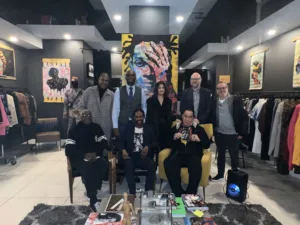Copyright Law Through the Lens of Photographer, Ernie Paniccioli

(Left to Right: Voza Rivers, Ulysses Williams, Ayeh Ohene-Asah, Dominque Banks, Andrea Timpone,Ernie Paniccioli, Chris Fladgate,Yosef Shwedel)
To begin 2023 and the launch of GS2Law’s Art Law Practice, our firm held a timely discussion with the legendary hip-hop and celebrity photographer, Ernie Paniccioli (a/k/a Brother Ernie). The Art Law Talk, held at The Dominici Collective[1], included a retrospective of Mr. Paniccioli’s work and experience as a photographer through the 80s and early 2000s. The conversation then covered some basic legal rights available under The Copyright Act, the pending Supreme Court decision in Goldsmith v. The Andy Warhol Foundation, and Mr. Paniccioli’s creative perspective on the practical implications of this case for artists.
Approaching the 50th Anniversary of Hip-Hop, Mr. Paniccioli’s infamous photographs of The Notorious B.I.G., Tupac, Missy Elliot, Jay-Z, Salt N Pepa, Rakim, Eminem, LL Cool Jay (the list goes on) are more iconic than ever. Mr. Paniccioli shared his personal interest and experience documenting the evolution of Hip-Hop culture in New York City. Acknowledging Mr. Paniccioli’s creative (and sometimes physical) feats to capture stunning shots, we learned that taking many photographs were life threatening! For example, Mr. Paniccioli shared an experience when photographing P. Diddy (f/k/a Puff Daddy) sitting with two live tigers. With that kind of dedication to his craft, we really understand his frustration with infringers. Indeed, Mr. Paniccioli and guest speaker Ayeh Ohene-Asah, Esq. acknowledged that now, with the proliferation of artificial intelligence, infringers may not even be human, and infringement all too easy.
Mr. Paniccioli acknowledged the competing concerns posed by Goldsmith v. Warhol and how it may impact the creative process. Acknowledging that there is a fine line between an artist using a prior work to create something new and ultimately exploiting that work for monetary gain, the line may get finer.
Currently, the general standard when considering whether a new work is entitled to the fair use defense because it is transformative, is to determine whether the new work offers a new meaning or message from its source material. In a landmark decision, the Supreme Court considered a new work to be transformative if it “adds something new, with a further purpose or different character, altering the first with new expression, meaning, or message.” Campbell v. Acuff Rose Music, Inc., 510 U.S. 569, 579 (1994). This standard has shepherded a whole generation of appropriation artists, including Richard Prince, Barbara Kruger, Elaine Sturtevant, KAWs, etc. Many of these artists have filed amicus briefs to the Supreme Court to weigh before issuing a decision in Goldsmith v. Warhol.
Critically, The Andy Warhol Foundation appealed the Second Circuit decision which held that courts should be forbidden from trying to understand the intent or meaning of the works at issue. In particular, the Second Circuit stressed that “even where a new work indisputably conveys a distinct meaning or message, the work is not transformative if it ‘recognizably deriv[es] from, and retain[s] the essential elements of, its source material.”
In their amicus brief, artists Barbara Kruger and Robert Storr emphasized, that this standard is a “misguided approach to fair use [and] creates a tremendous risk for many practicing artists who use, build on, or incorporate existing material into their works [and] threatens to chill rather than promote artistic expression…”[2] For The Andy Warhol Foundation, Warhol’s use of Lynn Goldsmith’s photograph of Prince, turns on the new meaning imparted by Warhol, such that Warhol’s work is a commentary on the commodification of Prince.
On the other hand, for artists such as Lynn Goldsmith and Ernie Paniccioli, there is a heightened concern when the new work becomes or threatens to become a substitute for the original and diminishes the original artists’ rights, including, licensing fees or royalties. Photographers are particularly susceptible given that their digital format is easier to copy than a sculpture, for instance. That said, the longstanding fair use test does factor in whether the new work will act as a market substitute in the overall analysis.[3]
The tenuous analysis of whether a new work is transformative may need a refresher of these existing factors and hopefully strike a balance consistent with the objectives of copyright law.
Speak with an IP Lawyer at GS2 Law in confidence. If you would like to know more about copyright protection and enforcement, we encourage you to get in touch. To schedule a confidential consultation with an IP lawyer at GS2 Law, please request an appointment online today.
[1] The Dominici Collective is a fashion boutique and art gallery located at 2090 7th Avenue, New York, NY 10027.
[2] Brief amici curiae of Barbara Kruger and Robert Storr, p. 5 (January 2022).
[3] Under Google LLC v. Oracle America, Inc., fair use is determined using the following factors: (1) the nature of the copyrighted work; (2) the purpose and character of the use; (3) the amount and substantiality of the portion used; and (4) the effect on the market or value of the copyrighted work. 141 S.Ct. 1183 (2021).
